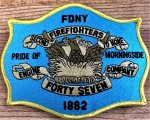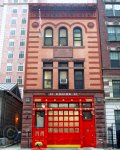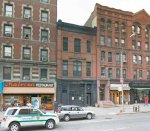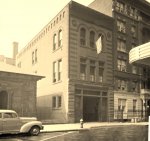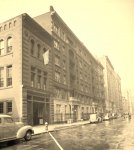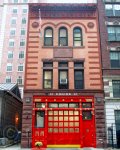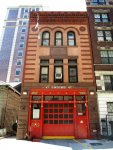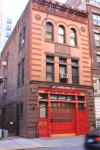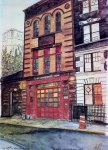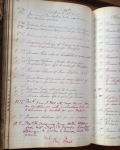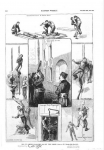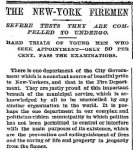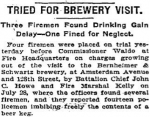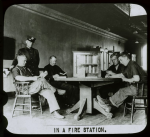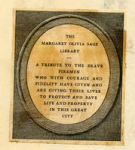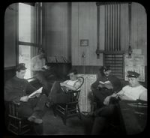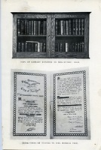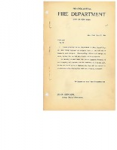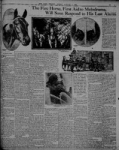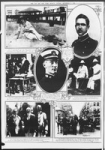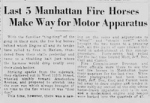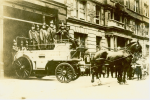ENGINE 47 (CONTINUED)
ENGINE 47 HISTORY
 ENGINE COMPANY NO. 47
ENGINE COMPANY NO. 47
This exhibit provides a history of Engine Company No. 47 from its beginnings as a combination engine company in 1882 through motorization in 1920. From 1883 to 1887, the company housed the Fire Department's first School of Instruction and Life-Saving Corps in its firehouse at 97th and Tenth Avenue. These programs trained and tested recruits and firemen, anticipating New York City's later adoption of Civil Service laws. In 1891, the company moved north to its handsome, newly completed brick firehouse on 113th Street. That year the company responded to 83 alarms, by 1911 the number would grow to 341. During these years, the firemen of Engine Company No. 47 served continuous duty, meaning that they were allowed only three hours a day away from the firehouse for meals and to see their families. In January 1920, Engine Company 47 moved to a two-platoon system and in August, the fire horses of Engine 47 were retired, and it became the last company in Manhattan to be motorized.
EARLY HISTORY: THE VOLUNTEER ERA (PRE-FDNY ENGINE 47)
1737-1830
The first volunteer force was organized in 1737 by the Common Council. By 1810 there were thirty-four engine and three hook and ladder companies.
1830-1865
Beginning with the 1830s, the volunteer fire companies were civic, social, familial, and political organizations, with membership the starting point for many political careers. Seven mayors elected after 1835 had been fireman, including William "Boss" Tweed, who was a founder of "Americus" Engine Company 33 in 1848. As many as 100 men could be associated with a single company, and companies were constantly disolving and reforming. Company officers were elected by the men in the companies.
Augustine Costello describes four separate Engine 47 companies during the volunteer era:
The first, the "Mechanics'" was organized March 10, 1928 for the protection of shipyards. It was located on the dry dock and the members were all shipwrights or builders. On June 22, 1842 it was organized into Hose Company No. 34.
"Their house was a small one, which had a bell on it, and a hole cut in the front door through which the rope attached to the bell could be reached to summon the firemen in case of fire. It was said that of the company that they used to 'grease their wheels with butter,' being too high-toned to use anything more common."https://mhdh.library.columbia.edu/e...pany_no_47/early-history--volunteer-era#_ftn2
The next Engine No. 47, "Aqueduct", was located on 82nd Street near Third Avenue. It was organized March 6, 1854 and was disbanded September 18, 1855.
The third, "New York", organized June 4, 1860 by members of the New York Hose Company No. 5, was housed with them in Firemen's Hall. This company was accused of repeatedly running a competing Hose Company off the road, and was disbanded March 24, 1864.
The last volunteer Engine Company No. 47, the "Croton" was organized on May 26, 1864. They were stationed at 165 W. 120th Street. The company was mustered out by the Paid Department in 1865.

Figure 1: Firemen's Hall on Mercer Street was the last firehouse constructed during the volunteer era. It would later house the headquarters of the Metropolitan Fire Department (1865-70) and the New York Fire Department (1870-1887).

Figure 2:
New York Times 25 (Mar 1864)
End of the Volunteer Era
Dissatisfaction with the volunteer fire department had been growing during the 1860s. Some volunteers were among the mob during the Draft Riots; the engine companies often raced each other to fires, running down the sidewalks and putting pedestrians at risk; and the insurance industry was unhappy with rising fire expenses.
In 1864, the Board of Fire Underwriters, concerned about the cost of the volunteer system appointed a committee to consider the subject of 'promoting great efficiency in the Fire Department,' which began collecting evidence against the Volunteer Department. Limpus reports that much of the evidence was supplied by the Police Department. The committee also surveyed other cities which reported being happy with their paid departments. In the spring of 1865, the Republican state legislature and Republican governor, eager to reduce Tweed's influence, replaced the volunteer companies with the Metropolitan Fire Department, exclusively under the direction of a Republican board of commissioners.
https://mhdh.library.columbia.edu/e...pany_no_47/early-history--volunteer-era#_ftn5

